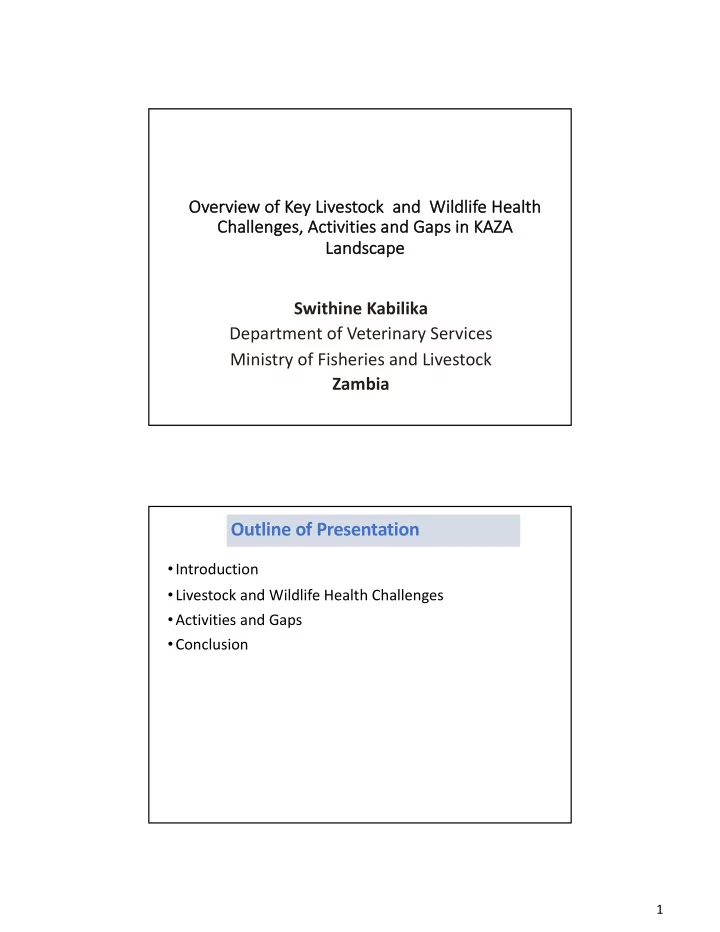

Ov Over erview of of Key Lives estoc ock and Wi Wildlife e Hea Health Ch Challenges, A Activities a and G Gaps i in KA KAZA Landsc ndscape pe Swithine Kabilika Department of Veterinary Services Ministry of Fisheries and Livestock Zambia Outline of Presentation • Introduction • Livestock and Wildlife Health Challenges • Activities and Gaps • Conclusion 1
Introduction Zambia is a Land linked country 8 neighbours Population is estimated at 16 million 50% of the population live in town and the other 50% in the rural area Zambia’s economy is dependent on minerals mainly copper Introduction-cont. • Livestock Population and distribution • Livestock is 35% of Ag GDP • Most livestock are found in the southern, Western and Eastern part of Zambia. • Livestock rearing in Zambia is centred on cattle which is about 4-5 million Cattle 4,984,909 Sheep 149,420 Goats 4,823,910 Pigs 2,146,762 Poultry 174,470,000 2
Introduction-cont. • Wildlife Distribution • The two main National Parks out of 20 are Kafue National Park and Luangwa National park (North and South) • Kafue National park is the second largest in world and covers 22,400 sqkm. • North and South Luangwa National parks cover 13,686 sqKm in the eastern part of the country National Parks of Zambia 3
Livestock and Wildlife Health Challenges • Occurrence of animal diseases • Disease control Not Notable Repor orted Animal Di Diseases DISEASE SPECIES AFFECTED AFFECTED AREAS Foot & mouth disease Cloven-hoofed animals Kafue flats Anthrax Mammals Western Zambia, lower Zambezi, Eastern Luagwa National Park Contagious Bovine Pleura Ruminants Western Zambia bordering Angola Pneumonia Heartwater Ruminants Through out the country Trypanosomosis Mammals Associated with Tsetse flies covers 2/3 of the country Rabies Mammals Through out the country Bovine Brucellosis Cattle; other mammals Production; zoonosis Bovine Tuberculosis Cattle; other mammals Mortality; production; zoonosis Theileriosis (Corridor) Cattle Occurs through out the country except western and northern parts of the counyty African swine fever Pigs Endemic in eastern part of the country New Castle Disease Birds Through out the country 4
DI DISEASE CONTROL • Trypanosomosis • Effects on cattle range from mortality to chronic debility • Zoonosis • No vaccine • Wildlife reservoirs 2014 20 2009 2009 • Tsetse eradication operations under 2006 2006 the Kwando-Zambezi 200 2001 regional Project 2002 2002 as at 2009, 2014 Ra Rabies es • Domestic dogs/wildlife • WHO/OIE/FAO Initiative to eliminate dog mediated rabies by 2025 • Through multisectoral approach (medics/vets/local authority) • Vaccination targeting 70% of the dog population • One health strategy has been developed 5
Anthrax • Periodic outbreaks in wildlife and livestock with high mortality in the recent past hippos were more affected. • Outbreaks usually occurs from November through December in Western and Eastern provinces • Major threat to Tourism and endangered species like lions African swine fever • Wild pigs /warthogs – reservoir host • Can cause high mortality in domestic pigs • No vaccine is available • Usually, the grave socio-economic effects of ASF are inflicted on rural poorer pig farmers and households who lack basic biosecurity facilities and may not effectively implement prevention and control measures. • Ban - Movement, sale of pigs and products, • Test and slaughter • Trade restriction – no market access for endemic regions 6
CBP CBPP • CBPP Affected KAZA countries: Angola, Namibia and Zambia • Morbidity and mortality as well as case fatality rates variable • Reported fatality rates ranges between 17-20% • Vaccination • Movement control – No wildlife Involvement • Slaughter of positive herds FMD • Apart from other parts of the country, Zambia has had a fair share of FMD outbreaks in KAZA area • SAT3 –Sioma /shangombo-2015 • OTHER AREAS • Type 0 –Northern Part the country • SAT 1 AND 2-Kafue 7
FMD outbreaks around KAZA TFCA 2010 to 2015 FMD • Vaccinations • High risk areas bi-annual vaccinations against SAT 1,2 • In western part of the country SAT3 • Northern Part of the country Type0 • Movement restrictions 8
Other challenges Facing Animal Disease Control Within KAZA KAZA is a human/livestock/wildlife interface that present many challenges from: Increasing human population and its ensuing demand on the land resource – encroachment, over use of resources and rapid land transformation Climate change – droughts, floods Unresolved issues arising from creation of NPs Wildlife migratory routes disturbed by new settlements Flood plains suitable for survival of both wild and domestic animals Failure to reconcile the interests and expectations of stakeholders with divergent views e.g., erection of fences along boundaries Wildlife Conservation at the expense of human life and livestock – source of conflicts. Different approaches in the management and control of animal diseases of economic importance, e.g. FMD, CBPP Few supported regional programs on how to manage zoonotic, livestock production and transboundary animal diseases within KAZA. GAPS • Regional multisectoral approach to livestock/wildlife disease control (vets/medics/conservationist/others) • Investment in regional information gathering & interpretation for early warning • Harmonization of animal disease control policies, legislation and programs for major animal diseases in KAZA • Investment in risk management along the value chains for both livestock and wildlife for assured market access. Investment in models to predict future outbreaks – currently we are reactive and not proactive – Knowledge of human, animal and environmental risk factors. • Limited capacity in Wildlife health at least for Zambia • Inadequate coord. betwn livestock and wildlife stakeholders 9
Conclusion KAZA offers opportunities for integrated animal disease control approaches that benefits humans (zoonotic diseases), wildlife and livestock (production and transboundary diseases) Livestock and wildlife offer direct benefits to households = poverty reduction and household food security. Poultry and small ruminants play a supplementary role Livestock is a NR that must be harnessed. 35% of Ag GDP in Zambia is from Livestock. What ever programs that could be done under KAZA should take into consideration Livestock. Th Thank you 10
Recommend
More recommend